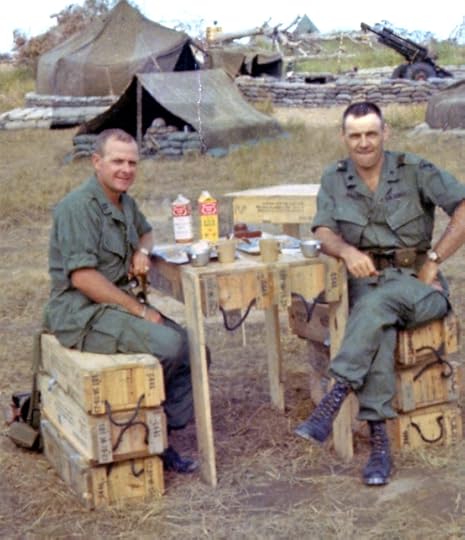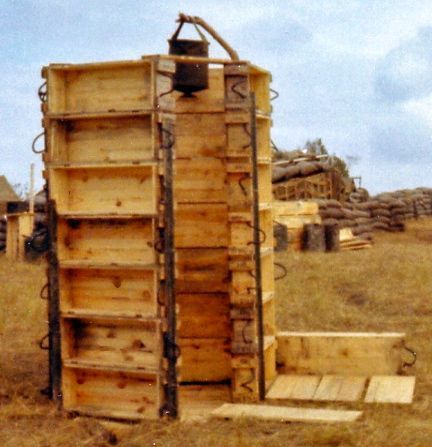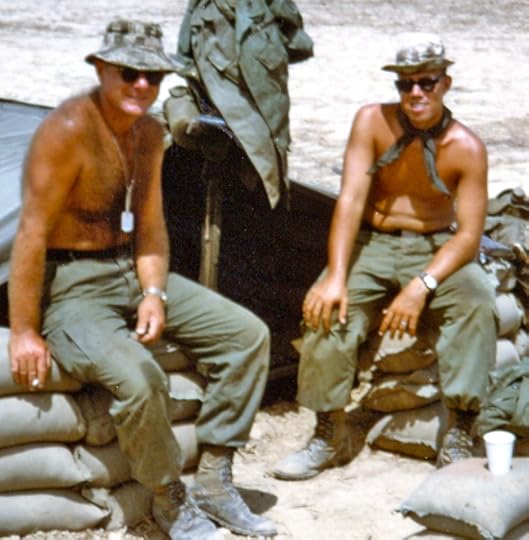George Moses – Battery Commander – Part Two
THE BOYS OF BATTERY B
GEORGE MOSES
BATTERY COMMANDER
PART TWO
Captain Moses spent the early months of his command tightening up battery procedures and overhauling the howitzers. The payoff for this hard work begins in December, 1967 with an operation in support of the Sky Soldiers of the 173rd Airborne.
“Oh How We Love You”
On December 5 we began the toughest operation of my tour in Vietnam. Ordinarily I would be leaving the battery at this time. The routine was six months in command and six months in a staff position. But there had been a change in policy that came out of the infantry accidentally firing on themselves with their own mortars and some of our artillery commanders firing accidentally on friendly troops. If you had a commander who had not had an incident, there was the option to keep him in command for a full year. Just before this operation Lieutenant Colonel House, who had replaced Lieutenant Colonel Munnelly as battalion commander, decided to leave me in command of B Battery. I was fine with that because I would have gone to a desk job somewhere.
We road marched the entire battery 80 miles south to Tuy Hoa and the next morning airlifted out to Landing Zone Clara where we settled in with a battalion of the 173rd separate infantry brigade, four companies of airborne infantry totaling about 500 men. On Christmas Eve, or maybe Christmas, Lieutenant Colonel House came out to have lunch with us and see how we were doing.

Captain Moses (left) and Lt. Colonel House Dining in High Style Christmas, 1967
I cannot resist interrupting Captain Moses to comment on this picture. “There’s a lot going on here. It shows the many uses of artillery ammo boxes, including the fancy table, and I see in the background your howitzer has its muzzle cover.”
Oh my lord, we couldn’t have survived without the ammo boxes. We built everything. We built shower stalls, latrines; we put down flooring with the wood; troops would make small homes from them around their howitzers.

Shower at LZ Clara
The operation began on the 27th at 7:00 in the morning. Our orders were to airlift the entire battery, all six guns, to a landing zone 15 miles north near a Special Forces camp at Dong Tre. We were to lay the battery and immediately register on seven potential locations where the infantry might land. Three of the locations would be decoys, the other four would be actual landing sites and were known only to the infantry battalion commander. Our orders were to be prepared to fire preps on the actual landing sites, three to four minutes of continues artillery fire immediately prior to the landing of troops by helicopter.
Three days after the operation, on New Year’s Eve, Captain Moses wrote a letter from the field to his wife and daughter describing the action.
We had about 700 rounds pre-spotted at the new position and brought about 800 rounds with us. We fired two preps and everything went normal. We fired the third prep about 0905 hours and the company that went in (Alpha company) got hit hard. We continued firing and by eleven o’clock we were down to 820 rounds. By 1:00 we were down to 300 rounds and yelling and calling for more ammunition. A tactical emergency was declared and all Chinooks were made available to haul ammunition for us. By 2:00 we were down to 125 rounds and still going strong. By 3:00 we started getting more ammunition and the firing fell off. By nightfall we had 2600 rounds. By morning we were back (down) to 2000 rounds (bringing the total to well over 2,000 rounds in 22 hours of around the clock firing).
Alpha Company was pinned down for about three hours while we fired in and around their perimeter. That evening at dusk they found a total of 104 bodies around their position, and saw evidence that many more had been dragged away in the night. The men of A Company would have kissed every man in our battery because they knew we had saved their lives.
The operational tempo got very fast because we figured out a way to get rounds out more quickly in response to a correction from the forward observer. That was one of the criticisms we in the artillery got, that it took too long to get rounds out after corrections. I was listening to the corrections coming from the forward observer to the Fire Direction Center, I was tuned in on that frequency. I was able to give the 1st sergeant a heads-up on which way in general the corrections were going to come out – left, right, up, or down. So the guns could begin moving in those directions while the FDC calculated the precise firing information. By anticipating we were shorting the time to get the rounds back out there. That was a departure from FM 6-40, but I could see that it was making us more responsive and it worked quite well for us. That was the payoff for being a well trained artillery unit.
We had a mountain of ammunition boxes from that operation. If we had stayed in that position we could have built a castle.
We burned the paint off some of those tubes. That’s where all the maintenance that we did at Qui Nhon paid off. Not one of those howitzers hiccupped at all. It was the damnedest thing. Ever since then I’ve been in love with the 105 howitzer.

1st Sergeant Roy and Captain Moses – Picture taken mid-mission around noon
Lieutenant Kerchoff was my forward observer. He and the radio operator were inserted with Alpha company. Kerchoff did one hell of a job directing fire for that infantry company. He received a Bronze Star With V-Device for Valor for his actions in that operation. Boy he was a fine young man. Here’s a case where you certainly didn’t want to judge the book by the cover. When you looked at Kerchoff you’d say he would never do what he did on that Dong Tre operation. He did it in spades. He performed like he was trained to do, and with courage.
When he came to the battery, I have to admit he didn’t look like much and I was a little skeptical of him . Because of what he did on that operation, I have never again judged a man by the way he looked. He showed the kind of courage you would love to have in every soldier. He came back from that operation a bigger person and a tougher person because of that experience.

Captain Moses and Lieutenant Kerchoff
As I recall there were not any U.S. casualties. The brigadier general in charge of the brigade and the captain in charge of A company came down to the battery and went around and shook the hand of every soldier they could find, and thanked them for saving their ass that day.
Late the next night we were listening to Saigon radio, and the disc jockey said that the men of Alpha Company dedicate the following record to B Battery of the 5/27 artillery. The song was Oh How We Love You. I thought that was priceless. It was what field artillery is all about – the close trusting relationship between infantry and field artillery.
Good Shooters
In early January we were directed to an operation back up at Qui Nhon Bay for Major Wright, who was the liaison to the Vietnam Regional Forces. These were like their national guard and reserves, not ARVN regular army. It was a strange operation. The entrance to Qui Nhon Bay was formed by the tip of a peninsula that formed the harbor entrance. The Viet Cong had set up on a reverse slope of the peninsula, on the ocean side, a protected position that controlled the entrance to the bay. There had been a lot of activity there and the operation was to clean out the VC.
We set up our howitzers on a causeway on the inland side of the bay. We had to fire high angle over the crest of that peninsula onto the reverse slope. It was particularly stressful on the gun crews because they had to lower that tube to load a round, and then crank the tube back up to fire. Those cannons weighed 5,000 pounds and totally controlled with hand wheels. You had to turn that hand wheel lots and fast. By the time the day was over my boys were just shot. They were worn out.
I say, “Firing high angle onto a downslope is also tricky business.”
The battery was technically qualified to do that, and they did it very well. Fire direction center handled it well, the forward observers handled it well, and the crews did a marvelous job. I was very proud of them for their gunnery and their firing battery operation that day.
During the mission a colonel came down from Qui Nhon city and was just standing there. I saw him and walked over and reported to him and asked if I could do anything for him. He said, “No captain, I just came down here to smell the cordite.” I guess he was a staff guy and he missed being around the guns.
After that we continued to support Major Wright on more missions. He would go out with the Regional Forces platoons and call for what he called it reconnaissance fire. He would use the artillery to fire in front of him as he was moving. He was training his platoon to flush out anything in front of them that looked suspicious. If he was moving cross country and he came across a hedge row or clump of trees or something that looked suspicious, and he was concerned about getting ambushed, he would stop and call for fire on that point to see if it would flush out anything.
Wright came by the battery area after one of those operations and had some coffee with me. He said, “George, I’m not going to tell you how close we’re bringing that stuff in.”
I said, “As long as you tell me its danger close, that’s all I need to know.”
He kind of laughed. “Well, it’s that, and sometimes a little more.”
“Well, as long as you call it in danger close, that’s what our procedures call for.”
“We’ll do that. But your accuracy is so good that we are confident.”
I did not go into deeper conversation, but I trusted he knew what he was doing and what the risks were. I felt really good about that. Of course I passed that onto the battery, and that just motivated them more to be better at their gunnery. When he gave me danger close we went into the danger close procedures in the FDC, and we made damn sure that the guns were moving the hand wheels in the right direction and taking out slack. Major Wright was in love with the battery.
We were real good shooters, and stayed good until we had one incident. I’ll talk about that later.



